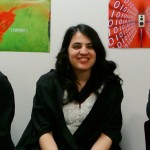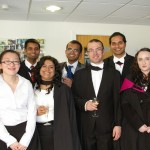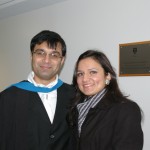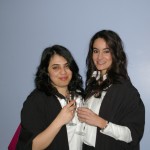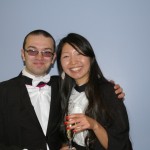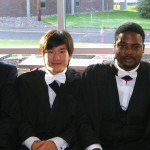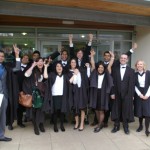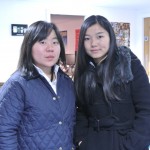Students representing the many MSc courses within Computer Science, stopped by the video room yesterday, to provide a short snippet of their MSc experience. Excellent work everyone. Videos will follow in due course. A bit of reflection and much hilarity ensued but here is a clue as to the personalities involved.
St Andrews Day Graduation 2012
Congratulations to the Masters Class of 2012, and our PhD students, who graduated yesterday. Students were invited to a reception in the school to celebrate their achievement with staff, friends and family. Our graduates have moved on to a wide variety of interesting and challenging employment and further study opportunities, and we wish them all well with their future careers.
Success in J.P.Morgan Code for Good Competition
A team of Computer Science students from the University of St Andrews came first in their category and runner up overall in the J.P.Morgan Code for Good Competition 2012
The Coding Challenge was open to all students enrolled fulltime at a university located in the United Kingdom, who are under-graduates or post-graduates and are 18 years of age or over. Students had to be on track for a 2:1. Teams of 4-6 students competed against each other on behalf of a charity assigned to them in order to provide a technological solution to a problem that the charity faces.
The team representing St Andrews was
- Aleksejs Sazonovs
- Anastasia Bugaenko
- Gareth Munro
- Kernius Kuolys
- Ole Sandbu
Seminar by Leo Liberti on “Symmetry in Mathematical Programming”, 19th Nov, 11am
Leo Liberti, the director of the Optimisation and Sustainable Development Chair at Ecole Polytechnique, will be giving a seminar on Monday 19th November, 2012, at 11am-12, in Jack Cole 1.33a.
Symmetry in Mathematical Programming
Abstract: When solving Mathematical Programming (MP) problems (be they linear or nonlinear, continuous or mixed-integer) using Branch-and-Bound (BB), the presence of symmetries of the solution set results in BB taking longer than strictly needed, due to the symmetries induced on the BB tree. I shall illustrate a class of “symmetry breaking” methods based on reformulating the symmetric MPs so that some of the symmetric optima become infeasible. I shall show how to automatically detect MP formulation symmetries by reducing MP to graphs, and how to automatically generate reformulated MPs with (hopefully) fewer symmetric optima. Although computational tests show that reformulations may not always succeed in making BB terminate faster, they can be applied very efficiently – so they can be considered an efficient “pre-solving step” to running BB.
Event details
- When: 19th November 2012 11:00 - 12:00
- Where: Cole 1.33a
- Format: Seminar
The Paterson Prize
Interested in writing science fiction then read on. The Paterson Prize was set up by one of our former employees Dr Norman Paterson for students in computer science who liked to write science fiction stories.
Closing date for entries is 31st March 2013
SICSA DEMOfest 2012
The Scottish Informatics & Computer Science Alliance in association with ScotlandIS hosted their 5th annual DEMOfest, a technology showcase of Scottish Universities Informatics and Computer Science on the 6th November.
The school had three posters at the DEMOfest. Derek and Gordon were promoting their work on the SFC funded Horizon Project “Services to the Cloud”, Masih’s poster was “On The Propagation of Network State Knowledge In Structured Peer-to-Peer Networks”, which forms part of his PhD, and Chris was talking about the work he’s been doing with Alex Voss on “Analysing Social Media”.
In addition, for the first time, workshops were included as part of the DemoFest. Gordon organised the first of these on the topic of Cloud Computing. The lunchtime workshop was aimed at software developers who are considering moving their product to the cloud, and comprised three invited speakers and an open panel Q&A/discussion session.
It was attended by 37 people from industry and academia, and is the first in a series of dissemination workshops being organised as part of the Services to the Cloud project.
Graduation November 2012
The School of Computer Science will be holding a Graduation Reception in the Jack Cole Building on Friday 30th November starting at 12:00 for the Masters Class of 2011. Students are invited to attend after their graduation along with any guests attending the event. Current MSc Students are also invited to the reception, which will continue until 17:00, to meet with the graduates and discuss their experiences both during the course and since they have left.
Event details
- When: 30th November 2012 09:30 - 15:30
- Where: St Andrews
Best Student Paper Award for iSCAN
Congratulations to Per Ola and colleagues Ha Trinh, Annalu Waller, Keith Vertanen and Vicki L. Hanson. Their paper “iSCAN: a phoneme-based predictive communication aid for nonspeaking individuals” received the ACM SIGACCESS Best Student Paper Award at the 14th International ACM SIGACCESS Conference on Computers and Accessibility (ASSETS 2012) earlier this year.
The Google Anita Borg Memorial Scholarship 2013 – Europe, the Middle East and Africa
As part of Google’s ongoing commitment to furthering Anita’s vision, we are pleased to announce the 2013 Google Anita Borg Memorial Scholarship: Europe, the Middle East and Africa. Doctor Anita Borg (1949 – 2003) devoted her life to revolutionizing the way we think about technology and dismantling the barriers that keep minorities and women from entering the computing and technology fields.
Who Should Apply?
*Be a female student enrolled in a Bachelor’s, Master’s or PhD program in 2013/2014.
*Be enrolled at a University in Europe, the Middle East or Africa.
*Study Computer Science, Computer Engineering, Informatics, or a closely related technical field.
*Maintain an excellent academic record.
The scholarship recipients will each receive a 7,000 EUR scholarship. All recipients will be invited to visit a Google office in Europe for a networking retreat.
For full details, please visit us at:
www.google.com/anitaborg/emea
Deadline to apply: February 1, 2013
2013 Google Europe Scholarship for Stuents with Disabilities
Access to knowledge is our passion. When it comes to higher education for promising scholars, we do not want anything to stand in the way. That is why we are pleased to announce the 2013 Google Europe Scholarship for Students with Disabilities.
Who Should Apply?*Be a student enrolled in a Bachelor’s, Master’s or PhD program in 2013/2014.
*Be enrolled at a University in Europe or Israel.
*Study Computer Science, Computer Engineering, Informatics, or a closely related technical field.
*Maintain an excellent academic record.
*Be a person with a disability.
The scholarship recipients will each receive a 7,000 EUR scholarship. All scholarship recipients will be invited to visit a Google office in Europe for an all-expenses-paid networking retreat.
Complete details at:
www.google.com/studentswithdisabilities-europe
Deadline to apply: February 1, 2013



